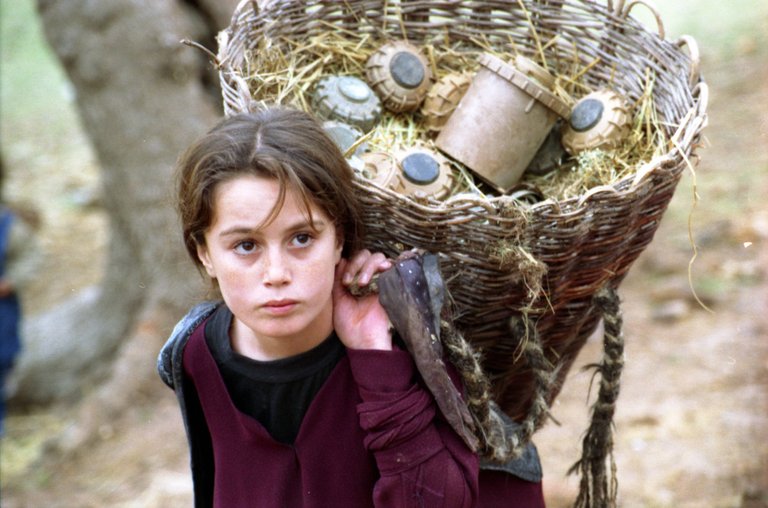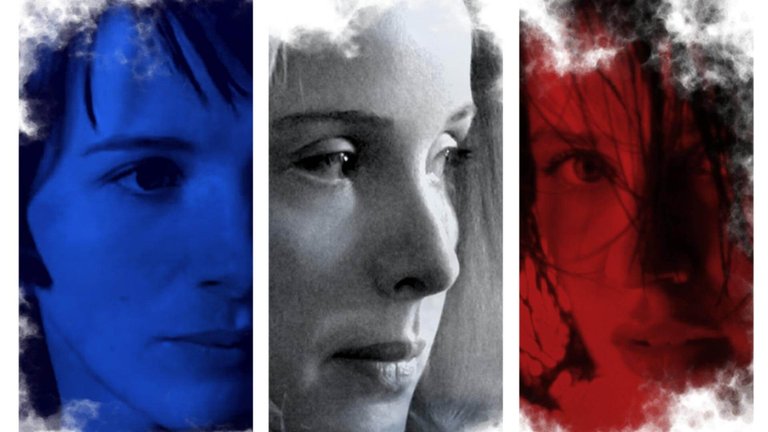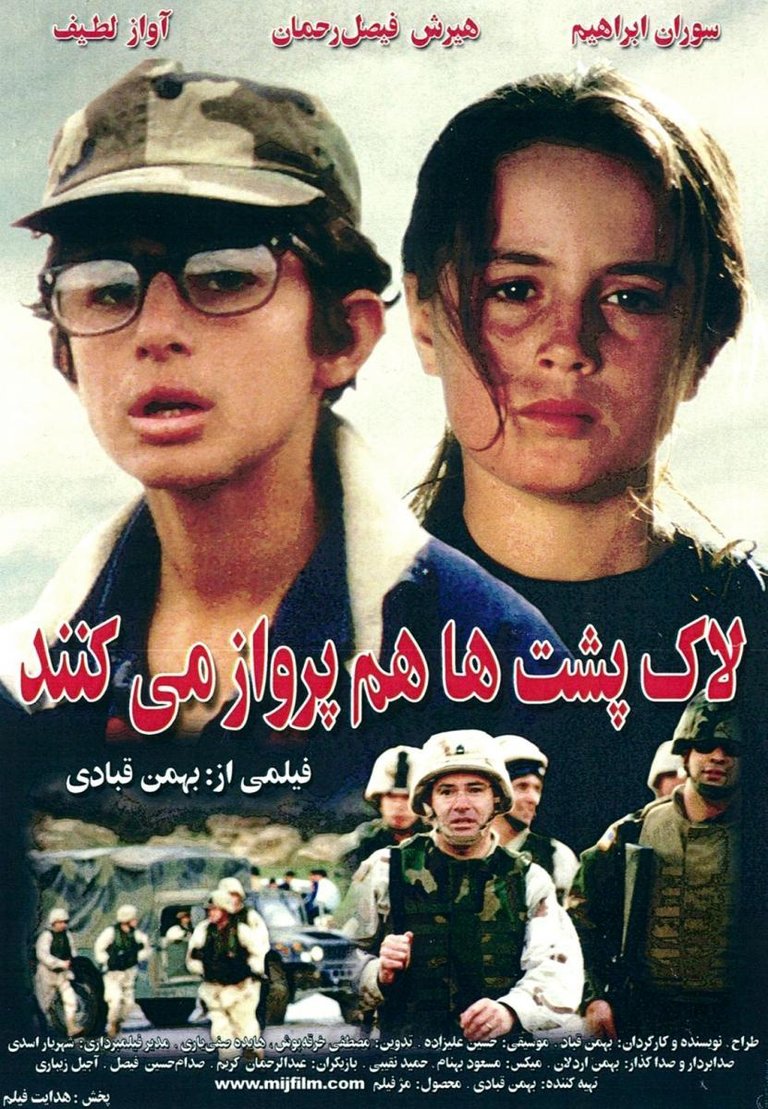Turtles Can Fly (2004): the cruelest side of war | el lado más cruel de la guerra

Escrita y dirigida por Bahman Ghobadi
There are stories that are sad, that leave you with a lump in your throat and a heavy feeling of defeat. There are other stories that are fun, that manage to make you laugh and smile with the occurrences of their characters. And there are also stories - usually with children - that mix tenderness with courage, sweetness with cruelty and victory with tragedy. And then there are stories, few but memorable, that mix all of the above and this film is one of those few.
Hay historias que son tristes, que te dejan con un nudo en la garganta y con una pesada sensación de derrota. Hay otras historias que son divertidas, que logran sacarte risas y sonrisas con las ocurrencias de sus personajes. Y también hay historias - normalmente con niños - que mezclan la ternura con el valor, la dulzura con la crueldad y la victoria con la tragedia. Y luego hay historias, pocas pero memorables, que mezclan todo lo anterior y esta película es una de esas pocas.
Lâkpošthâ ham parvâz mikonand (Turtles Can Fly) is the most famous film by Bahman Ghobadi, an Iranian director of whom I had not yet seen anything until now, but who with just this work is already - on my personal list - at the level of the big names of cinema in the region such as Abbas Kiarostami and Asghar Farhadi. This film is as honest as it is unforgettable and as beautiful as it is painful. The story, set in 2003, begins in Kurdistan, near the border between Iraq and Turkey, a few days before the US attacks Iraq to remove Saddam Hussein from power. There are rumors of war, but services are precarious in a small town in the region and the national government has censored television, so the inhabitants are blind. The war could start at any moment and they wouldn't know. For that reason they want to purchase a very large satellite dish that allows them to access international channels and there is a boy from the village, who is nicknamed Satelite, who knows how to install these devices. Satelite is loved and respected by the children of the village, scarred by the war before it begins: poor, orphaned, hungry and some of them painfully amputated while doing one of the few jobs they could do to earn some money: deactivating the anti-personnel mines that different armies have placed in different areas and then sell them on the black market, can you imagine a more bleak panorama for children?
Lâkpošthâ ham parvâz mikonand (Turtles Can Fly) es la película más famosa de Bahman Ghobadi, un director iraní del cual aún no había visto nada hasta ahora, pero que con apenas este trabajo ya está - en mi lista personal - al nivel de los grandes nombres del cine de la región como Abbas Kiarostami y Asghar Farhadi. Y es que esta película es tan honesta como inolvidable y tan hermosa como dolorosa. La historia, ambientada en el año 2003, inicia en Kurdistán, cerca de la frontera entre Irak y Turquía, unos días antes de que los EEUU ataquen Irak para sacar del poder a Saddam Hussein. Hay rumores de guerra, pero los servicios son precarios en una pequeña villa de la región y el gobierno nacional ha censurado la televisión, así que los habitantes están a ciegas. La guerra podría comenzar en cualquier momento y ellos no se enterarían. Por esa razón desean adquirir una antena parabólica muy grande que les permita acceder a canales internacionales y hay un chico de la villa, a quien apodan Satélite, que sabe cómo instalarlar esos aparatos. Satélite es querido y respetado por los niños de la aldea, marcados por la guerra antes de que empiece: pobres, huérfanos, hambrientos y algunos de ellos dolorosamente amputados mientras ejercían uno de los pocos trabajos que podían hacer para recoger algo de dinero: desactivar las minas anti personas que han colocado diferentes ejércitos en diferentes áreas de la zona para luego venderlas en el mercado negro, ¿se puede imaginar un panorama más desolador para la infancia?

These children, between the ages of three and fifteen, perhaps less, are forced to become adults and live in a distorted universe. Their playground is a minefield, the threat of war seems like a game, they are still children, because they joke, laugh and cry as such, but their childhood was dynamited by the war and now they have to fight for it. survive in the midst of uncertainty, misery, hunger, orphanhood and confusion.
Estos niños, entre los tres y los quince años, acaso menos, están obligados a convertirse en adultos y viven en un universo distorsionado. Su patio de juegos es un campo minado, la amenaza de la guerra parece a su vez un juego, no dejan de ser niños, porque bromean, ríen y lloran como tales, pero su infancia fue dinamitada por la guerra y ahora tienen que luchar por sobrevivir en medio de la incertidumbre, la miseria, el hambre, la orfandad y la confusión.
As days go by, more and more children begin to live in the place as refugees and in the middle of them all appears Agrin, a girl with whom Satellite falls in love from the first time he sees her. The girl's parents have been murdered by Saddam Hussein's soldiers and she finds herself traveling with an armless boy who has visions of the future and a two-year-old little boy who appears to be his little brother. The relationship or link that exists between the three of them is not entirely clear, but their paths cross several times with that of Satellite and the children of the village while everyone waits for the American planes to appear at any moment. It is a simple plot, with a good rhythm, but whose strength lies, I believe, in two elements. The first of them is authenticity. Ghobadi hired non-professional Kurdish youth and children who had experienced that episode firsthand and that adds verisimilitude to their performances and expressions. And the other element is the emotional mix of its characters: love, friendship, sadness, pain, tenderness, helplessness, rage, cruelty, fun, Turtles Can Fly touches all - or almost - the emotional fibers of being human and shows them in scenes as memorable as the opening sequence of the film, Satélite's declaration of love to Agrin or those armless hugs that a child gives to another smaller one.
Conforme avanzan los días, más y más niños comienzan a hacer vida en el lugar en calidad de refugiados y en medio de todos ellos aparece Agrin, una niña de quien Satélite queda prendado desde la primera vez que la ve. Los padres de la niña han sido asesinados por soldados de Saddam Hussein y ella se encuentra viajando con un niño sin brazos que tiene visiones del futuro y un pequeño de dos años que parece ser su hermanito. La relación o nexo que existe entre ellos tres no queda del todo clara, pero sus caminos se cruzan varias veces con el de Satélite y los niños de la aldea mientras todos esperan que en cualquier momento aparezcan los aviones norteamericanos. En verdad es una trama sencilla, con buen ritmo, pero cuya fuerza está, creo yo, en dos elementos. El primero de ellos es la autenticidad. Ghobadi contrató a jóvenes y niños kurdos no profesionales que habían vivido ese episodio en carne propia y eso le aporta verosimilitud a sus actuaciones y expresiones. Y el otro elemento es la mezcla emocional de sus personajes: amor, amistad, tristeza, dolor, ternura, impotencia, rabia, crueldad, diversión, Turtles Can Fly toca todas - o casi - las fibras emocionales del ser humano y las muestra en escenas tan memorables como la secuencia inicial de la cinta, la declaración de amor de Satélite a Agrin o esos abrazos sin brazos que un niño da a otro más pequeño.

It's important to note that these children (and the director) are not only Iranian, they are Kurdish. Kurdistan is a territory (not a country) that is currently divided between Turkey, Iran, Iraq and Syria, its inhabitants have a strong identity and culture, but despite this they cannot avoid the feeling of not having a home of their own because their borders have been blurred over the years and are both from everywhere and from nowhere.
Es importante señalar que estos niños (y el director) no son solamente iraníes, son kurdos. Kurdistán es un territorio (no un país) que actualmente está repartido entre Turquía, Irán, Irak y Siria, sus habitantes poseen una identidad y una cultura fuerte, pero a pesar de ello no pueden evitar la sensación de no tener un hogar propio porque sus fronteras se han ido desdibujando con el pasar de los años y son a la vez de todos lados y de ninguna parte.
Refugees, threats of war, black market, landmines, the panorama is not the most conducive for children and yet these children have to live in these circumstances and bear the consequences of the decisions of the adults to kill each other. This, I believe, is the cruelest side of war, the one that cuts off childhood, the one that condemns not only the present but the future because these children - if they do not receive the necessary help - will grow up to become traumatized adults (some of They have already lost a member due to the explosion of a mine) and it must be one of the cruelest things that, as humanity, we can do. So yes, this story is sad and very painful, but it's not made from a perspective of giving pity but rather to create awareness, to denounce and also to rescue that ray of hope that children (and love) are sometimes, even in the most complex circumstances. Impeccable direction, a very good script, honesty, verisimilitude, emotion, tragedy, hope, this film, the first filmed in Iraq after the fall of Saddam Hussein, is a heartbreaking but beautiful story, especially recommended for those who love films like The Kite Runner, Wadjda, Persepolis or the films by Abbas Kiarostami and Asghar Farhadi, have any of you seen it? Do you know any other movies like this? I read you in the comments.
Refugiados, amenazas de guerra, mercado negro, minas antipersonas, el panorama no es el más propicio para la infancia y sin embargo estos niños tienen que hacer vida en esas circunstancias y cargar con las consecuencias de las decisiones de los mayores de matarse entre ellos. Este, creo yo, es el lado más cruel de la guerra, el que cercena la infancia, el que condena no solamente el presente sino el futuro porque estos niños - si no reciben la ayuda necesaria - crecerán para convertirse en adultos traumados (algunos de ellos ya perdieron algún miembro por la explosión de alguna mina) y debe ser una de las cosas más crueles que, como humanidad, podemos hacer. Así que sí, esta historia es triste y muy dolorosa, pero no está hecha desde una perspectiva de dar lástima sino de crear consciencia, de denunciar y también de rescatar ese rayito de esperanza que a veces son los niños (y el amor), incluso en las circunstancias más complejas. Una dirección impecable, un guión muy bueno, honestidad, verosimilitud, emoción, tragedia, esperanza, esta película, la primera filmada en Irak después de la caída de Saddam Hussein es una historia desgarradora, pero hermosa, recomendada especialmente para quienes aman las películas como The Kite Runner, Wadjda, Persepolis o las cintas de Abbas Kiarostami y Asghar Farhadi, ¿alguno de ustedes la ha visto? ¿conocen alguna otra película como esta? Los leo en los comentarios.
Reseñado por @cristiancaicedo
Other posts that may interest you | Otros posts que pueden interesarte:
  |
|---|


